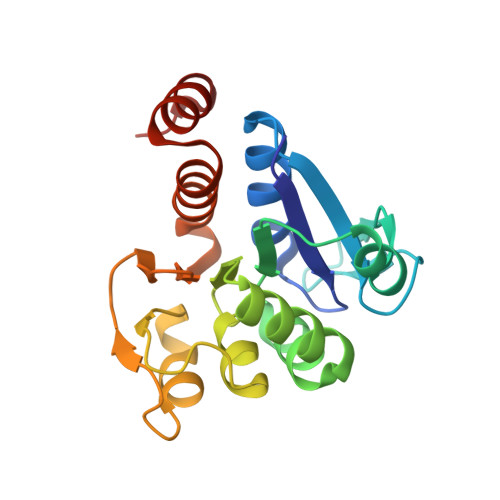Transnitrosylation from DJ-1 to PTEN attenuates neuronal cell death in parkinson's disease models.
Choi, M.S., Nakamura, T., Cho, S.J., Han, X., Holland, E.A., Qu, J., Petsko, G.A., Yates, J.R., Liddington, R.C., Lipton, S.A.(2014) J Neurosci 34: 15123-15131
- PubMed: 25378175
- DOI: https://doi.org/10.1523/JNEUROSCI.4751-13.2014
- Primary Citation of Related Structures:
4RKW, 4RKY - PubMed Abstract:
Emerging evidence suggests that oxidative/nitrosative stress, as occurs during aging, contributes to the pathogenesis of Parkinson's disease (PD). In contrast, detoxification of reactive oxygen species and reactive nitrogen species can protect neurons. DJ-1 has been identified as one of several recessively inherited genes whose mutation can cause familial PD, and inactivation of DJ-1 renders neurons more susceptible to oxidative stress and cell death. DJ-1 is also known to regulate the activity of the phosphatase and tensin homolog (PTEN), which plays a critical role in neuronal cell death in response to various insults. However, mechanistic details delineating how DJ-1 regulates PTEN activity remain unknown. Here, we report that PTEN phosphatase activity is inhibited via a transnitrosylation reaction [i.e., transfer of a nitric oxide (NO) group from the cysteine residue of one protein to another]. Specifically, we show that DJ-1 is S-nitrosylated (forming SNO-DJ-1); subsequently, the NO group is transferred from DJ-1 to PTEN by transnitrosylation. Moreover, we detect SNO-PTEN in human brains with sporadic PD. Using x-ray crystallography and site-directed mutagenesis, we find that Cys106 is the site of S-nitrosylation on DJ-1 and that mutation of this site inhibits transnitrosylation to PTEN. Importantly, S-nitrosylation of PTEN decreases its phosphatase activity, thus promoting cell survival. These findings provide mechanistic insight into the neuroprotective role of SNO-DJ-1 by elucidating how DJ-1 detoxifies NO via transnitrosylation to PTEN. Dysfunctional DJ-1, which lacks this transnitrosylation activity due to mutation or prior oxidation (e.g., sulfonation) of the critical cysteine thiol, could thus contribute to neurodegenerative disorders like PD.
- Neuroscience and Aging Research Center.
Organizational Affiliation:
















